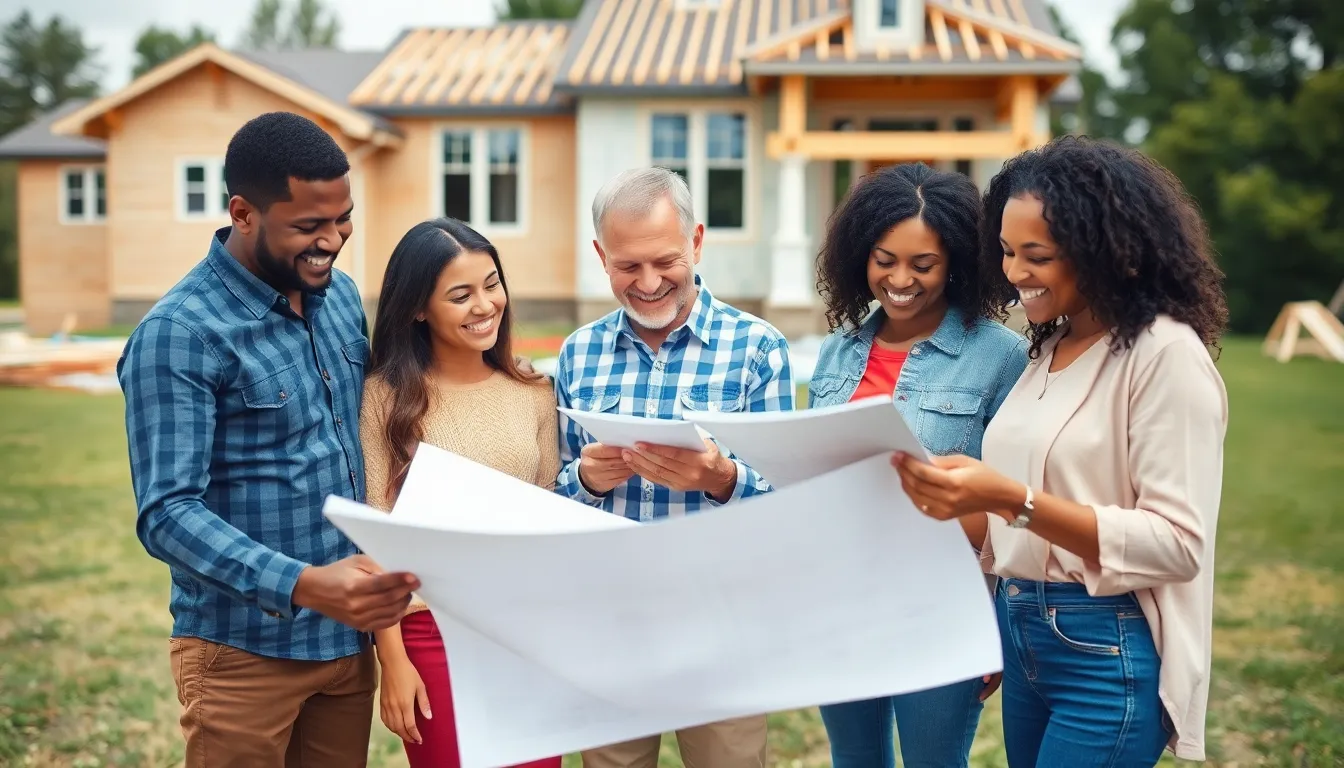Building a new home is like crafting a masterpiece—only with fewer paint splatters and more potential for arguments over where the couch should go. For many, it’s the ultimate dream, a blank canvas ready to be transformed into a sanctuary. But before diving headfirst into blueprints and contractor meetings, it’s essential to understand the ins and outs of new home construction.
Table of Contents
ToggleOverview of New Home Construction
New home construction involves several critical phases, each requiring thorough planning and execution. It encompasses land acquisition, design, permitting, and actual building. Understanding these phases helps homeowners navigate the complexities.
Planning stages often identify priorities, such as location, budget, and design preferences. This stage also includes researching local zoning laws and building codes that dictate what can be constructed.
Architectural design follows planning, where homeowners collaborate with professionals to create blueprints. Designers integrate functionality, aesthetics, and local climate considerations into the home plans. This process usually incorporates homeowner feedback to ensure the final design aligns with their vision.
Permitting is another essential step. Obtaining permits before breaking ground ensures compliance with local regulations. Inspections may occur throughout the construction process to ensure adherence to safety standards.
Construction represents the physical aspect of home building. Site preparation, foundational work, framing, and finishing are executed in this phase. Contractors manage timelines, labor, and materials to deliver a high-quality home.
Homebuyers often encounter various choices when selecting fixtures, finishes, and landscaping. These decisions impact not only the home’s appearance but also its long-term functionality and maintenance.
Many factors influence the entire construction process, including labor availability, supply chain dynamics, and weather conditions. Staying informed about these elements helps homeowners make well-informed decisions throughout their journey.
Choosing the right builder is vital for a successful project. Researching builders’ reputations and reviewing past projects offers insights into their capabilities. Collaboration and communication with the builder throughout the construction process ensures alignment with homeowner expectations, fostering a positive experience.
Benefits of New Home Construction

New home construction provides a range of benefits that can significantly enhance the homeowner’s experience. Understanding these advantages aids in making informed decisions throughout the building process.
Customization Options
Customization options allow homeowners to design spaces that meet their specific needs and preferences. Homeowners benefit from tailoring layouts to suit their lifestyle, whether they prefer open-concept designs or defined rooms. Materials and finishes can be chosen to reflect personal taste. Custom kitchens, unique bathroom layouts, and energy-efficient features represent a few examples of available choices. Overall, it empowers homeowners to create environments that resonate with their vision.
Energy Efficiency
Energy efficiency plays a vital role in modern home construction. New homes often incorporate advanced technologies and materials that enhance energy performance. Insulated windows, energy-efficient appliances, and smart home systems contribute to reduced utility costs. Techniques such as passive solar design can optimize natural light and temperature regulation. As a result, homeowners experience lower energy bills and a reduced environmental impact. Energy savings and increased comfort enhance the overall value of a new home.
Key Considerations Before Building
Building a new home involves several critical considerations. Planning effectively leads to successful project execution.
Budget and Financing
Budgeting plays a vital role in the home construction process. Establishing a clear financial plan helps homeowners avoid overspending. Consider all costs including land acquisition, materials, labor, and permits. Financing options include conventional loans, FHA financing, and construction loans. Researching local lenders can provide competitive rates and terms. Consult financial advisors for tailored advice to manage budgets throughout the project. Always factor in contingency funds to address unexpected expenses, typically 10-20% of the total budget.
Location and Land Selection
Location significantly impacts the overall success of a new home construction. Proximity to schools, workplaces, and amenities often influences buyer satisfaction. Evaluate environmental factors such as climate, topography, and access to utilities. Assess local zoning laws and regulations to ensure compliance with building requirements. Selecting a desirable neighborhood can enhance property value over time. Land size and shape affect design choices, so prioritize finding a plot that aligns with building plans. Consider future developments in the area, as they can alter the landscape and overall appeal of the location.
The Construction Process
The construction process involves several structured stages to bring a new home to completion. Homeowners engage in critical planning and design, followed by various construction phases.
Planning and Design
Planning stages set the foundation for successful home construction. Homeowners evaluate location, budget, and design preferences. Understanding local zoning laws influences the choice of land. Architectural professionals collaborate with homeowners to create detailed blueprints that match their vision. During this phase, functionality balances aesthetics to ensure the home meets personal needs. Effective communication with designers streamlines decision-making, leading to a cohesive plan that addresses potential concerns early.
Construction Phases
Construction phases consist of multiple key steps that develop the home. Site preparation begins with clearing and leveling land. Next, foundational work establishes a stable base. Framing follows, creating the structural skeleton that supports walls and roofs. After that, contractors focus on roofing, plumbing, and electrical installations. Finishing touches may include drywall, painting, and flooring. Timely progress requires active management of materials and labor throughout the process. Homebuyers address choices like fixtures and landscaping early, impacting both the home’s immediate appeal and long-term functionality.
Trends in New Home Construction
New home construction trends focus on sustainability and technology. As homeowners seek efficient and eco-friendly solutions, these trends shape the construction landscape.
Sustainable Materials
Sustainable materials play a crucial role in modern home building. Builders often choose locally sourced options that minimize environmental impact. Recycled metals and reclaimed wood enhance durability while reducing waste. Additionally, eco-friendly insulation materials contribute to energy efficiency. Homeowners benefit from lower utility costs thanks to improved thermal performance. Choosing these materials fosters a healthier living environment. Ultimately, sustainability in construction meets both aesthetic and functional needs.
Smart Home Technology
Smart home technology increasingly integrates into new homes. Automation systems manage lighting, heating, and security, enhancing convenience. Many homeowners prefer energy-efficient appliances that contribute to reduced utility expenses. Monitoring systems provide insights into energy consumption, enabling informed decisions. Connectivity options allow seamless integration of smart devices, offering personalized control. Smart technology can also enhance home security with features like remote monitoring. Embracing this technology creates a modern living experience tailored to individual preferences.
Building a new home is an exciting journey filled with possibilities. By understanding the construction process and making informed decisions, homeowners can create a space that truly reflects their vision. From selecting the right location to choosing sustainable materials and smart technologies, each choice plays a vital role in the overall success of the project.
Effective communication with builders and designers ensures that the homeowner’s needs are met while navigating challenges along the way. With careful planning and attention to detail, the dream of a custom-built home can become a reality, offering comfort and value for years to come. Embracing this journey leads to a living environment that’s not only functional but also uniquely personal.


